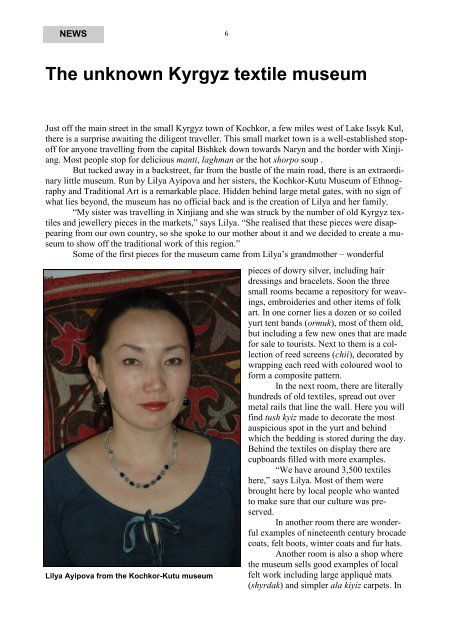Download - OATG. Oxford Asian Textile Group
Download - OATG. Oxford Asian Textile Group
Download - OATG. Oxford Asian Textile Group
Create successful ePaper yourself
Turn your PDF publications into a flip-book with our unique Google optimized e-Paper software.
NEWS<br />
6<br />
The unknown Kyrgyz textile museum<br />
Just off the main street in the small Kyrgyz town of Kochkor, a few miles west of Lake Issyk Kul,<br />
there is a surprise awaiting the diligent traveller. This small market town is a well-established stopoff<br />
for anyone travelling from the capital Bishkek down towards Naryn and the border with Xinjiang.<br />
Most people stop for delicious manti, laghman or the hot shorpo soup .<br />
But tucked away in a backstreet, far from the bustle of the main road, there is an extraordinary<br />
little museum. Run by Lilya Ayipova and her sisters, the Kochkor-Kutu Museum of Ethnography<br />
and Traditional Art is a remarkable place. Hidden behind large metal gates, with no sign of<br />
what lies beyond, the museum has no official back and is the creation of Lilya and her family.<br />
―My sister was travelling in Xinjiang and she was struck by the number of old Kyrgyz textiles<br />
and jewellery pieces in the markets,‖ says Lilya. ―She realised that these pieces were disappearing<br />
from our own country, so she spoke to our mother about it and we decided to create a museum<br />
to show off the traditional work of this region.‖<br />
Some of the first pieces for the museum came from Lilya‘s grandmother – wonderful<br />
Lilya Ayipova from the Kochkor-Kutu museum<br />
pieces of dowry silver, including hair<br />
dressings and bracelets. Soon the three<br />
small rooms became a repository for weavings,<br />
embroideries and other items of folk<br />
art. In one corner lies a dozen or so coiled<br />
yurt tent bands (ormuk), most of them old,<br />
but including a few new ones that are made<br />
for sale to tourists. Next to them is a collection<br />
of reed screens (chii), decorated by<br />
wrapping each reed with coloured wool to<br />
form a composite pattern.<br />
In the next room, there are literally<br />
hundreds of old textiles, spread out over<br />
metal rails that line the wall. Here you will<br />
find tush kyiz made to decorate the most<br />
auspicious spot in the yurt and behind<br />
which the bedding is stored during the day.<br />
Behind the textiles on display there are<br />
cupboards filled with more examples.<br />
―We have around 3,500 textiles<br />
here,‖ says Lilya. Most of them were<br />
brought here by local people who wanted<br />
to make sure that our culture was preserved.<br />
In another room there are wonderful<br />
examples of nineteenth century brocade<br />
coats, felt boots, winter coats and fur hats.<br />
Another room is also a shop where<br />
the museum sells good examples of local<br />
felt work including large appliqué mats<br />
(shyrdak) and simpler ala kiyiz carpets. In
















